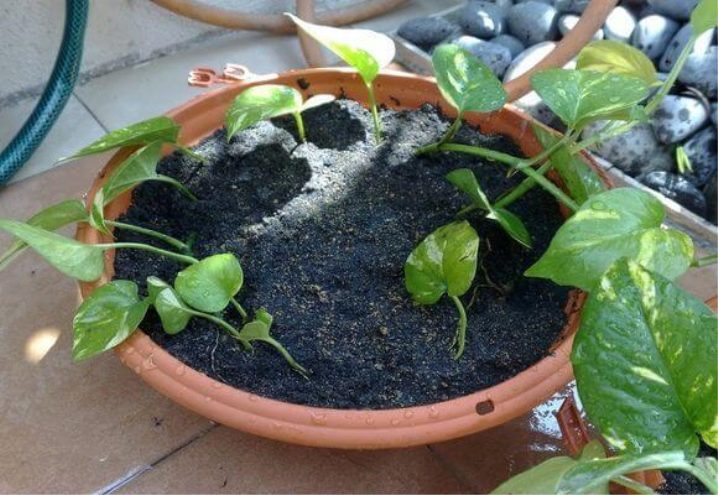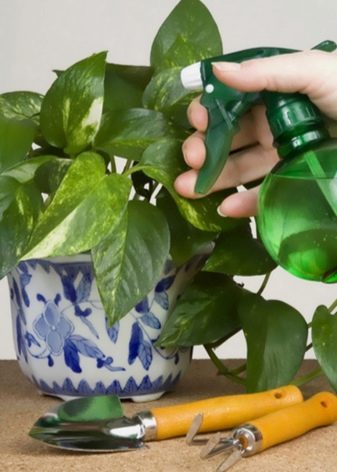Breeding methods dieffenbachia

The birthplace of Dieffenbachia is the tropics. In the wild, the reproduction of this plant has been worked out for centuries, but it is not difficult to get offspring at home. A young, large and fast-growing bush can be removed literally in one summer - for this, vegetative and seed propagation is used.
General principles
It is completely easy to propagate dieffenbachia, regardless of the technique used, so even an inexperienced florist can cope with this task, but it is extremely important to create conditions for the plant that are optimal for growth and development. It is sensitive to the characteristics of irrigation, illumination, temperature and humidity levels in the room. An important role in the rate of root formation and growth of new flowers is played by a properly selected substrate in which dieffenbachia will root and grow.
The optimum temperature for flower reproduction is 23-25 degrees Celsius., you should not put a flower pot near heating devices (radiators, radiators and fireplaces), but it is also not recommended to keep it on a cold windowsill or in places where constant drafts are observed. A young immature plant will simply die in such conditions. The flower loves well-lit places, but the main thing is avoid exposure to direct ultraviolet rays, the light must be necessarily diffused.
The air in the room must be humidified, otherwise the leaves begin to turn yellow and fall - reproduction in such a situation is unlikely to be successful. It is optimal to turn on a humidifier or at least a room fountain for several hours a day; in the absence of such devices, you can put a wet towel on the battery or regularly spray the area of the room near dieffenbachia from a spray bottle.
For irrigation, use soft water at room temperature, moisten the soil carefully, avoiding waterlogging. If there is too much water, then the roots of the young seedling will begin to rot, and the plant will die before it can grow. The spring months are suitable for the propagation of dieffenbachia in houses and apartments.

It is best to do this in the second half of March or April, it is during this period that the plant comes out of hibernation and dormancy and begins to grow and develop intensively.
Reproduction methods
The seed propagation method of dieffenbachia is rarely used in practice. The fact is that the flowers of this green pet appear only in conditions as close as possible to natural - tropical, and it is quite problematic to create such a microclimate in a living room. In botanical and winter gardens, as well as greenhouses, flowers sometimes appear, but the female and male inflorescences are on different sides, therefore, pollination is carried out manually, which is characterized by a rather low efficiency.
That is why this type of reproduction is mainly used by breeders to develop new varieties, and on an ordinary windowsill, the plant is propagated by vegetative methods. Dieffenbachia is propagated in several ways:
- cuttings;
- rooting of leaves;
- air layering.
Cuttings
This is the easiest and fastest type of propagation of dieffenbachia, which can be done even by novice growers who do not have much experience in breeding exotic plants. For reproduction, apical and stem cuttings are taken, but lateral shoots are never used in practice.The fact is that lateral buds are awakened extremely rarely in artificial conditions, therefore, growing a full-fledged plant from such a shoot in most cases turns out to be ineffective. For propagation, you can take cuttings of different sizes - even a piece 2-3 cm long will give good roots.
To work you need to prepare:
- a sharp knife or scalpel;
- rubber gloves;
- glass container:
- methylene blue;
- Activated carbon.

To begin with, cut off the top of the plant, and cut the rest of the stem into small pieces up to the root collar. The length of each can be absolutely any - it all depends on how many cuttings you want to get. The cut pieces are washed under running water at room temperature so that all the juice comes out, and then dried for 3-4 hours.
While the cuttings are drying, it is necessary to prepare the substrate - for this, boiled or filtered water is tinted with pharmacy blue (not to be confused with household blue), and activated or charcoal, crushed into powder, is added at the rate of 1 teaspoon per 1 liter of water. These additives prevent waterlogging and root rot.
Prepared cuttings are moved into prepared water, they can be placed both upright and flat. Keep in mind that a fairly large container will be needed for the top with branches, otherwise the vessel may turn over. To make the roots appear faster, it is recommended to add a little root-forming preparations to the water with cuttings. The most effective are "Kornevin" and "Heteroauxin" - as soon as the very first roots appear, supplements should be stopped.
Some growers recommend at this stage to add a tablet of ascorbic acid with glucose to the water. These active components of the drug contribute to the full growth and development of roots, as well as stimulate the appearance of lateral shoots. Water should be renewed every 3-7 days, while the frequency of renewal directly depends on the number of cuttings in one vessel - the more there are, the more often you need to update.
After the appearance of several roots, you can transplant the cutting into the prepared soil mixture. Planting 1-3 shoots is allowed in one pot.

We draw your attention to the fact that dieffenbachia juice is poisonous and irritates the mucous membrane, therefore, all work on propagation by cuttings should be carried out with protective gloves, and if the juice gets into your eyes, you should rinse them with plenty of running water as soon as possible.
Sheets
Reproduction of dieffenbachia by a leaf method, as a rule, does not give a full guarantee of a 100% result, situations arise when young shoots grown in this way die for a variety of reasons. However, you can try. To do this, cut off a green, healthy and dense leaf, preferably the lower one, located as close to the roots as possible. This is done with a sharp, well-disinfected knife, the leaf plate is cut into several equal lengths and dried in the open air for several hours.
Such "blanks" are rooted either in water or directly in the ground. It is better to use growth stimulants so that the rooting process goes as quickly as possible. After transplanting leaf fragments into a suitable soil, the vessel must be covered with glass or plastic wrap - in this way, conditions are created that are close to greenhouse ones. As soon as roots appear on the planting site, they must be immediately transplanted into the earthen mixture to a permanent place.

Air layering
This dieffenbachia breeding technique is not as simple as the two described above, but its effectiveness is quite high. An incision is made on the exposed part of the stem with a very sharp knife, and then inserted into its small support - it can be a wooden stick or an ordinary match. If this stage is neglected, then the incision will simply overgrow.Experienced growers even remove a layer of bark 1-2 cm wide in a circle.
The opened areas are treated with a root formation stimulator, wrapped with wet sphagnum and covered with polyethylene. From time to time, the moss needs to be watered, it must remain wet. The film is fixed with a rope and left in this position for 2 months. Usually, roots appear at this point, then the branch can be cut off and transplanted into the prepared nutrient soil.


Possible problems
When tropical dieffenbachia breeds, all sorts of problems can arise. Let's dwell on the most common ones.
- In small cuttings, leaves wither and fall. The reason here is that the leaves tend to intensively evaporate moisture, and in conditions when the root system is developed, the plant may not have enough water, it begins to get rid of the foliage. To prevent this from happening, often spray the leaves and the air around them from a spray bottle. However, you should not worry - even if all the leaves fall off, then after the appearance of young roots, new ones will grow.
- Roots do not appear in water for too long... This means that the cuttings do not take root. This happens when breeding is carried out during the dormant period - in winter or autumn. Or if the shoots are taken from the oldest, lower part of the stem. Try to do all breeding work in the spring and summer. If you have only adult plants at your disposal, then cut pieces only from the top, and after cutting, be sure to keep them for a couple of hours in growth stimulants, for example, in "Heteroauxin". For a more effective procedure, cover the vessel with foil or glass to create a greenhouse environment. It is advisable to spray dieffenbachia every 3-4 days with diluted "Zircon", this will help to root the plant faster.
- Cuttings rot in water. The reasons in this case may be poor quality water or an infection brought in during cutting. To avoid such unpleasant situations, it is necessary to use soft water, be sure to add crushed coal and close the walls of the container from direct ultraviolet rays. However, it is always possible to correct the situation - you just need to remove all the rotten parts, dry them and re-place them in a container with disinfected water.
- The cuttings rot in the ground. The reason is the excessively high humidity of the earth and air, as well as incorrectly compiled soil. Often a similar problem occurs when a bacterial infection is introduced into the cut site or if a vessel with water is located in a cold place. The soil in which rooting takes place should be moist, not soggy; watering the soil is necessary only after the topmost layer has dried by 7-10 mm.


Use only heated water, pay special attention to the location of the container with layering - they should be placed in a warm place, staying on a cold windowsill is unacceptable.
Advice
It is advisable to place a young plant obtained from a cuttings, cuttings or leaves in the first year on windows located in the western or eastern directions. It is desirable to maintain diffused lighting. The optimum air temperature is 20-25 degrees, the humidity level must be medium, and watering should be carried out as needed - after the top layer of the earth is completely dry.
Keep in mind that the flower is drawn towards the light, so the orchid should be periodically turned to the sun in different directions - otherwise, the stem may bend, it will be impossible to return it straightness. Once every 2 weeks, top dressing should be carried out - it is better to use complex preparations developed specifically for dieffenbachia.
This plant is very fond of spraying - do not refuse him and moisten the leaves every day, and besides, from time to time give him a warm shower - do not forget,that your green pet comes from the tropics and therefore high humidity contributes to its fastest growth and development. Do not forget that this is a poisonous plant, therefore, it should not be placed in the nursery, as well as in the access area of pets, especially rodents.





























The comment was sent successfully.